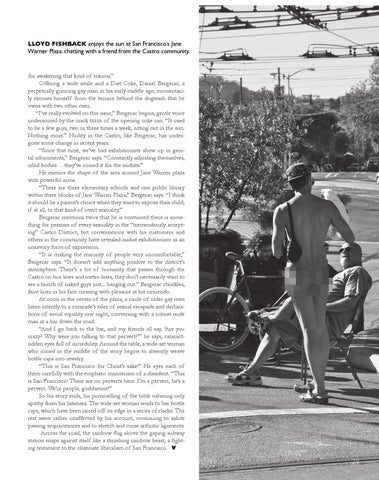LLOYD FISHBACK enjoys the sun at San Francisco’s Jane Warner Plaza, chatting with a friend from the Castro community.
for awakening that kind of trauma.” Offering a wide smile and a Diet Coke, Daniel Bergerac, a perpetually grinning gay man in his early middle age, momentarily excuses himself from the terrace behind the dogwash that he owns with two other men. “I’ve really evolved on this issue,” Bergerac begins, gentle voice underscored by the crack tzzzz of the opening coke can. “It used to be a few guys, two or three times a week, sitting out in the sun. Nothing more.” Nudity in the Castro, like Bergerac, has undergone some change in recent years. “Since that time, we’ve had exhibitionists show up in genital adornments,” Bergerac says. “Constantly adjusting themselves, oiled bodies …they’ve ruined it for the nudists.” He mimics the shape of the area around Jane Warner plaza with powerful arms. “There are three elementary schools and one public library within three blocks of Jane Warner Plaza,” Bergerac says. “I think it should be a parent’s choice when they want to expose their child, if at all, to that kind of overt sexuality.” Bergerac mentions twice that he is convinced there is something for persons of every sexuality in the “tremendously accepting” Castro District, but conversations with his customers and others in the community have revealed nudist exhibitionism as an unsavory form of expression. “It is making the majority of people very uncomfortable,” Bergerac says. “It doesn’t add anything positive to the district’s atmosphere. There’s a lot of humanity that passes through the Castro on bus lines and metro lines, they don’t necessarily want to see a bunch of naked guys just... hanging out.” Bergerac chuckles, faint lines in his face creasing with pleasure at his innuendo. At noon in the center of the plaza, a circle of older gay men listen intently to a comrade’s tales of sexual escapade and declarations of social equality one night, conversing with a robust nude man at a bar down the road. “And I go back to the bar, and my friends all say, ‘Are you crazy? Why were you talking to that pervert?’” he says, cataractridden eyes full of incredulity. Around the table, a wide-set woman who joined in the middle of the story begins to absently weave bottle caps into jewelry. “This is San Francisco for Christ’s sake!” He eyes each of them carefully with the emphatic mannerism of a dissident. “This is San Francisco! There are no perverts here. I’m a pervert, he’s a pervert. We’re people, goddamnit!” So his story ends, his pummelling of the table ushering only apathy from his listeners. The wide-set woman tends to her bottle caps, which have been jarred off its edge in a series of clacks. The rest seem rather unaffected by his account, continuing to salute passing acquaintances and to stretch and curse arthritic ligaments. Across the road, the rainbow flag above the gaping subway station snaps against itself like a thrashing rainbow beast, a fighting testament to the obstinate liberalism of San Francisco. v
A
FRENCH WOMAN WALKS HER on Nov. 20 by one vote that prohibits “genitals, anal-area and perineum” from the streets and parks of San Francisco’s historically ultra-liberal district, which includes the Castro. The ban applies only to those above the age of five, and violation of it is punishable by a potential $500 fine. It will apply to neither street fairs nor parades, and has been unanimously supported by the district’s neighborhood services committee. The reaction from the radical community has been to question the necessity of legislation restricting public nudity. In the same article by Joshua Sabitini that appeared in the SF Examiner, Wiener is quoted saying that gay men make up the “dominant demographic” of the ban’s supporters. In the same article, Supervisor David Campos is quoted saying that he is “still trying to understand why [anti-nudity] legislation was a priority.” Slate Writer William Saetan feels that the nudist ban is the product of gay conservatism. “The rise of same-sex households isn’t making society queer. It’s making gay people bourgeois,” the article cites. Saetan goes on to support the ban, stating that the public nudity movement was an affront to the gay community and falsely adopted their rhetoric in its campaign for freedom of sexual expression. “[The ban] is an interesting experiment in acceptance,” says Richard, a San Francisco nudist who refrains from sharing his last name. “[The ban] is an interesting experiment in acceptance,” says Richard, a San Francisco nudist who refrained from sharing his last name. “The line between ‘nude’ and ‘lewd’ is pretty ambiguous,” Richard says. He notes a disagreement in the legislation’s premise and its enforcement, saying somewhat sardonically that “it’s interesting to me that nudity is going to be reserved for the Folsom Street Fair and Gay Pride [both famously prurient events].” The French woman and her son sit down for breakfast at a bar overlooking Jane Warner Plaza. Unwrapping burnished silverware from linen swans, they don’t give a second look to the practically nude, wiry figure who looms at the hill’s crest. A sequined butterfly on his loincloth winks in the light as he reaches the plaza, a mirage and its violet star in the afternoon sun. “I think that the nudity on Castro is something that tourists really appreciate, it’s iconic,” says Lloyd Fishback, a prominent nudist in the San Franciscan community, the butterfly covering his genitals threatening to take flight on a passing breeze. Averting eye contact and in a self-conscious tone, Fishback concedes that locals of the Castro may not agree with his lifestyle on account of some “bad apples” whose
29
